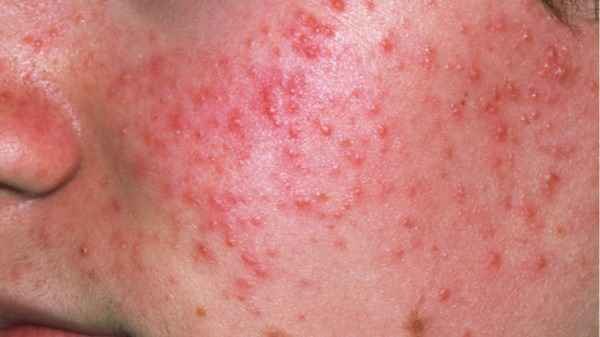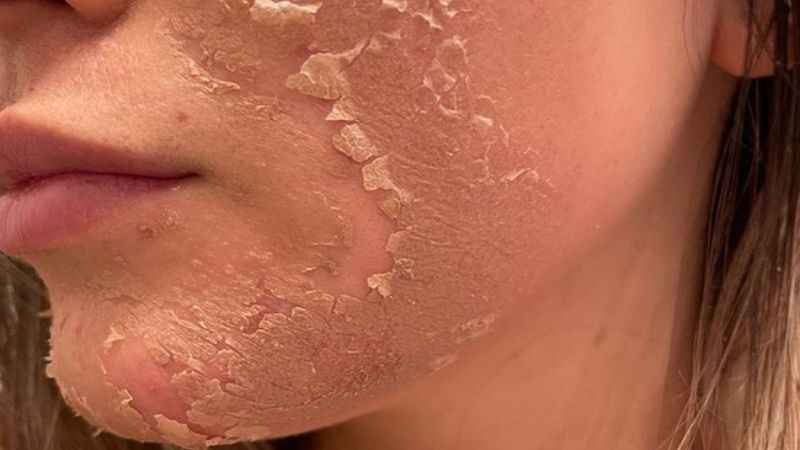Chemical peeling is a popular skincare method that helps improve pigmentation and skin texture. However, is it good to peel skin a lot is a question that leaves many people wondering. In this article, HBIO Clinic will help you understand the pros and cons of frequent skin peeling and whether it truly benefits your skin or does more harm than good.
What is Skin Peeling?
Skin peeling is a cosmetic technique that uses active ingredients such as Glycolic Acid, Salicylic Acid, or Retinol to exfoliate the skin’s surface. This process removes dead skin cells and promotes the regeneration of new, smoother, and brighter skin. As a result, common concerns like acne, pigmentation, enlarged pores, and fine lines can be significantly improved.
However, because the mechanism of action mildly affects the epidermis, skin peeling may cause temporary redness, dryness, or flaking. To ensure safety and achieve optimal results, it’s essential to determine a proper peeling frequency and strictly follow the post-treatment skincare regimen.

Is It Good to Peel Skin a Lot?
Although skin peeling offers various benefits—such as brightening the complexion, fading dark spots, and supporting acne treatment—many still wonder: Is it good to peel skin a lot? In fact, dermatologists warn that overusing chemical peels in a short period of time can cause serious damage to the skin. Some of the common risks include:
Severe Skin Peeling on the Surface
Frequent chemical peels or the use of deep peeling methods can lead to excessive flaking of the skin. The skin may become red, inflamed, and more prone to scarring or even infections if not properly cared for. This is a sign that the epidermis has been damaged and the skin needs time to regenerate.
Skin Becomes More Sensitive
Each peel thins the outer layer of the skin, and without adequate recovery time, the skin will become noticeably weaker. As a result, it becomes more reactive to sunlight, dust, and even regular skincare products. Symptoms such as redness, burning, or itching may occur frequently, causing discomfort and reducing the effectiveness of beauty treatments.
Persistent Stinging or Burning Sensation
Using high-concentration peeling agents or peeling too often can trigger a burning or stinging sensation. This may indicate a mild chemical burn.
If not treated properly, this condition can persist and negatively affect the overall structure and health of the skin.

Risk of Hyperpigmentation and Dark Spots
After a peel, the newly revealed skin is highly sensitive to sunlight. Without proper sun protection, the treated areas can easily develop hyperpigmentation, dark spots, or melasma. This not only affects the skin’s appearance but can also be very difficult to treat once it spreads over a large surface. That’s why when asking “Is it good to peel skin a lot?”, it’s crucial to consider post-peel care.
Breakouts May Reoccur
Peeling at the wrong time—especially when the skin is still in recovery—can cause clogged pores due to residual dead skin cells. This creates an environment where bacteria thrive, leading to breakouts such as whiteheads, inflammatory acne, or clogged pores. If left unchecked, the condition may worsen and be harder to manage.
Deep Skin Damage and Higher Risk of Infection
Over-peeling can thin the skin’s protective barrier (stratum corneum), weakening the skin’s natural defense. As a result, bacteria, pollutants, and allergens can penetrate more easily into deeper layers of the skin, increasing the risk of infections, dermatitis, and even chronic skin issues. This is considered one of the most serious consequences of overusing chemical peels.
Ideal Chemical Peel Frequency: How Often Should You Get a Peel?
The ideal chemical peel frequency is not one-size-fits-all. It depends on several factors, including your skin type, current skin condition, treatment goals, and the type of peel or active ingredients used.
To determine how often you should get a chemical peel, consider these common cases:
- Light peels using AHA/BHA: Suitable for oily, acne-prone skin or those looking to brighten skin tone gently. Recommended frequency: 1–2 times per month.
- Medium to deep peels using TCA or Retinol: These penetrate deeper into the skin and require longer recovery time. Recommended frequency: 1–2 times per year.
- Mechanical peels (e.g., microdermabrasion): These can be done every 2–4 weeks, depending on how well your skin adapts.
Regardless of the method, overdoing it can damage your skin’s natural barrier, leading to irritation, peeling, or unwanted inflammation. According to dermatologists, waiting 4–6 weeks between peels is best. This allows the skin to rest, repair, and fully regenerate between treatments for optimal results.

Who Should Not Get a Chemical Peel?
While chemical peels offer many skin benefits, this treatment is not suitable for everyone. Certain skin conditions and health concerns may lead to adverse reactions if the peel is performed on the wrong candidate. Below are the main chemical peel contraindications to keep in mind:
- Individuals with severe inflammatory acne, especially cystic acne or pustules.
- Skin that is chronically irritated, easily allergic, or currently damaged.
- Areas with open wounds, scratches, or unhealed lesions.
- Those who have not used any skincare products regularly in the past 6 months.
- People undergoing treatment for chronic health conditions such as diabetes or heart disease.
- Clients in the middle of intensive dermatological treatments.
- Those who have recently undergone surgery or are preparing for invasive procedures.
- Skin that is sunburned, peeling, or photosensitive.
- Individuals using prescription topical treatments within the last 7 days.
- Those who have taken Isotretinoin (Accutane) in the last 6–12 months.
- Pregnant or breastfeeding women.
- Elderly individuals with fragile, thin skin and deep wrinkles.

Should You Do a Chemical Peel at Home? Where Is the Safest Place to Get a Chemical Peel?
Performing a chemical peel at home is not recommended by dermatologists, as the procedure requires precise technique and strict adherence to safety protocols. Many peel solutions contain strong acids, and improper application or incorrect concentrations can lead to burns, irritation, hyperpigmentation, or even permanent scarring.
Instead of putting your skin at risk, it’s best to visit a professional skincare clinic where trained specialists can thoroughly assess your skin. HBIO Clinic is a trusted destination known for its team of experienced dermatologists who provide safe, customized chemical peel treatments tailored to your specific skin condition.
In summary, the question “Is it good to do chemical peels frequently?” is one that many people ask when exploring skin rejuvenation methods. Overdoing chemical peels can thin the skin, increase sensitivity, and lead to various complications. For optimal results, it’s important to follow expert guidance and choose the right timing and technique for your skin type.


 Tiếng Việt
Tiếng Việt
Dr. Thai Nguyen – Founder and Medical Director of HBIO Clinic. As an expert in aesthetic dermatology, she regularly shares in-depth knowledge and practical experience to provide valuable and insightful information for those seeking better skin health.